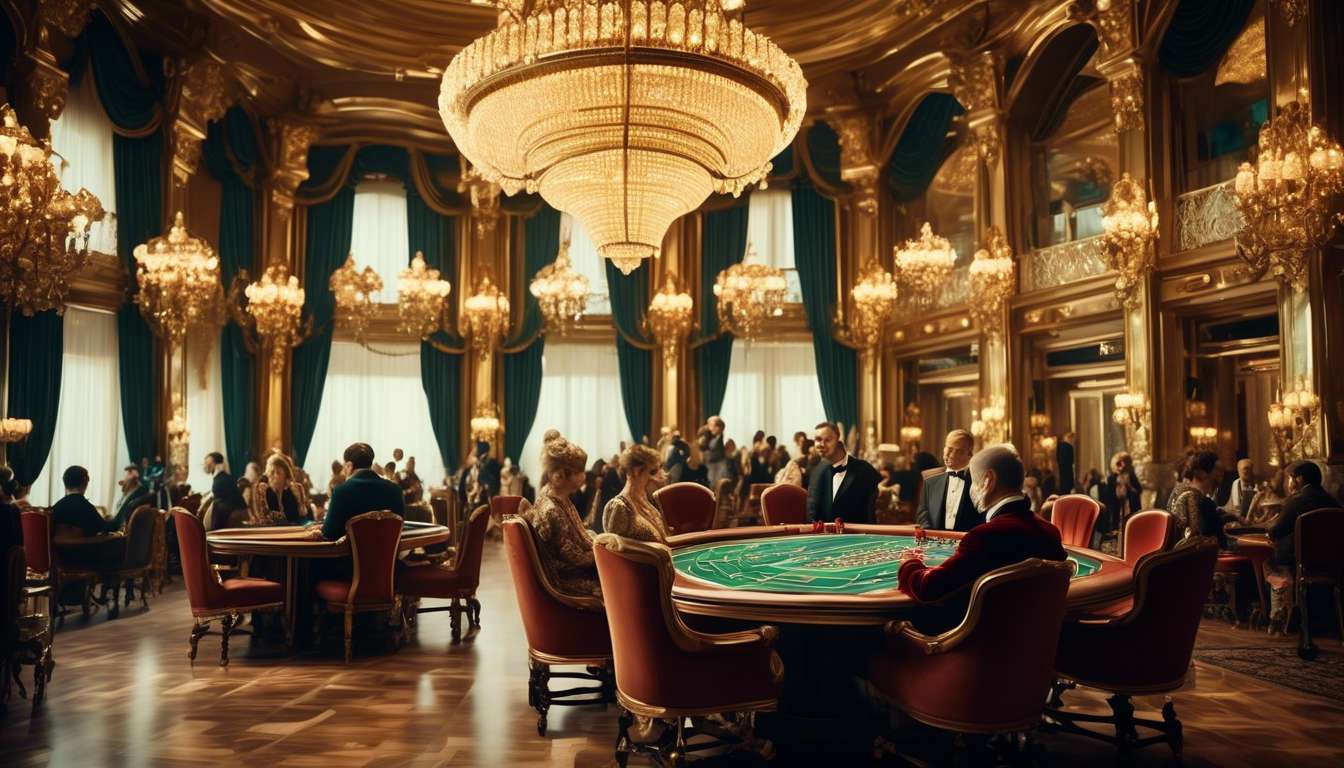As we embark on this exploration of Russian casino history, we find ourselves on a journey through time, uncovering the key moments that have shaped this fascinating industry.
Together, we will delve into the vibrant tapestry of Russia’s gambling past:
- The opulent casinos of the imperial era
- The stringent regulations of the Soviet period
- The modern landscape of legalized and thriving gaming establishments
As we traverse these historical milestones, we gain a deeper understanding of how cultural, political, and economic forces have influenced the evolution of casinos in Russia.
We will examine the pivotal events and influential figures that have left an indelible mark on this industry, shedding light on how these elements have contributed to the dynamic panorama we witness today.
Join us as we unravel the intriguing saga of Russian casinos, a story of resilience, adaptation, and transformation across decades.
Imperial Era Casinos
During the Imperial Era, Russia’s elite frequented opulent casinos that reflected the grandeur and extravagance of the time. These venues weren’t just about gambling; they were social hubs where aristocrats gathered, forging connections and solidifying their place in society.
As we strolled through these lavish establishments, we could feel the buzz of excitement in the air, with each roll of the dice or turn of a card offering a thrilling escape from daily life.
Gambling was more than a pastime; it was an integral part of our cultural fabric. Casinos provided a space for us to indulge in high-stakes games, shrouded in opulence and exclusivity.
However, it wasn’t all laissez-faire; regulations were in place to ensure that gambling was conducted within certain bounds, protecting the interests of both the players and the state. These rules helped maintain a balance by:
- Allowing us to enjoy the thrill of the game.
- Ensuring the integrity of these prestigious establishments.
Soviet Era Restrictions
Under Soviet rule, we witnessed a stark transformation as stringent restrictions on gambling dismantled the once-thriving casino culture. These regulations were part of a broader ideological shift that dismissed casinos and gambling as symbols of bourgeois decadence, incompatible with the new societal norms.
The Soviet authorities sought to cultivate a collective identity focused on productivity and equality, leaving little room for what they deemed frivolous pastimes. As a result, we saw the closure of casinos, as gambling was officially outlawed in 1928.
The government’s view on gambling was twofold:
- A moral issue that needed addressing.
- A threat to social cohesion.
By eliminating gambling, they believed they could foster a unified community grounded in shared labor and socialist values.
Despite these strict regulations, informal gambling persisted underground, reflecting a resilient human desire for risk and reward. We can imagine the whispered stories of secret games, a testament to the enduring allure of gambling, even when faced with prohibitive constraints.
Legalization of Gambling
In a dramatic shift from Soviet policies, the 1980s marked the resurgence of gambling as the government began to legalize and regulate the industry. This era brought significant change, reintroducing the thrill of casinos and gambling into our society.
With new regulations, we navigated a landscape filled with opportunities for entertainment and community gatherings.
The legalization of gambling wasn’t just about placing bets; it was about creating spaces for connection and shared excitement. Casinos emerged as social hubs, offering more than just games of chance. They became places where we:
- Celebrated victories
- Learned from losses
All within a structure designed to ensure fairness and safety.
By embracing these regulations, we fostered a sense of belonging among gamblers and non-gamblers alike. This legalization reflected our collective desire to participate in a vibrant and thriving part of our cultural tapestry.
Together, we welcomed this new chapter in Russian history.
Peter the Great’s Influence
Peter the Great’s fascination with Western culture laid the groundwork for Russia’s early encounters with gambling. As he sought to modernize Russia, he encouraged the adoption of various Western practices, including gambling. This new pastime wasn’t just about the thrill; it was a way to connect with the broader European community, sharing in customs that brought people together.
Casinos began to emerge as social hubs where the elite could engage in games of chance. Gambling wasn’t merely an indulgence; it symbolized a forward-thinking Russia, eager to embrace change.
However, as with any burgeoning trend, regulations soon became necessary. We saw the importance of establishing clear rules to:
- Ensure fair play.
- Maintain order.
These early regulations laid the foundation for future casino policies, balancing the allure of gambling with the need for structure.
Together, we embraced this new chapter in Russian history, marking a significant step towards modernization and cultural integration with Europe.
Tsar Nicholas II’s Policies
Under Tsar Nicholas II, gambling policies were tightened as measures were introduced to curb the excesses that had begun to emerge. He understood the importance of creating a community that thrived on stability and order. With casinos becoming increasingly popular, Tsar Nicholas II felt the need to implement stricter regulations to ensure gambling didn’t undermine societal values.
The Tsar’s policies focused on:
- Controlling the growth of gambling establishments by limiting their numbers.
- Ensuring casinos operated under close scrutiny to maintain societal values.
As a collective, we embraced the sense of belonging these regulations provided, knowing that they aimed to protect us from potential moral decay. By doing so, we felt a shared responsibility towards maintaining our cultural integrity, while still enjoying the thrill casinos offered.
In this era, gambling wasn’t just an individual pursuit; it was a communal experience, shaped by the rules set forth under Tsar Nicholas II. We remained connected, not just by chance, but by the collective efforts to preserve our society’s fabric.
Impact of World Wars
The turbulence of the World Wars dramatically reshaped our gambling landscape, forcing many establishments to close or adapt to new realities. As war ravaged the globe, casinos faced unprecedented challenges. Our beloved gambling halls, once vibrant with life and laughter, found themselves under strict regulations or shuttered entirely. The focus shifted from leisure to survival, a stark reminder of the fragile nature of our pastimes.
In the chaos, gambling regulations tightened, reflecting the nation’s need to redirect resources. Many of us remember stories of how our communities rallied together, sharing memories of better days while waiting for peace to return.
Casinos that managed to remain open adapted by:
- Altering their offerings
- Aligning with government priorities
These adaptations ensured they didn’t fall afoul of the authorities.
Through this tumultuous period, we learned the importance of unity and resilience. While the World Wars disrupted our gambling traditions, they also forged a deeper sense of belonging and camaraderie among us.
Post-Soviet Casino Boom
The collapse of the Soviet Union in 1991 sparked a remarkable resurgence in our gambling scene, igniting a casino boom across Russia. We welcomed a newfound sense of freedom, and with it, casinos began sprouting up in cities like Moscow and St. Petersburg. Gambling became not only a thrilling pastime but also a symbol of our entry into the global economy. We relished the excitement and camaraderie found within the opulent walls of these establishments.
However, this rapid growth wasn’t without its challenges. In our enthusiasm, we encountered a lack of regulations, leading to a chaotic environment where illegal operations sometimes thrived. Despite these issues, many of us found a sense of community and adventure in the bustling casino halls.
We navigated this new era with mixed emotions, balancing the joy of newfound freedoms with the realization that proper regulations were needed to ensure the sustainability and integrity of our beloved gambling spaces.
Our shared experiences in this era shaped our collective identity.
Current Regulatory Framework
In recent years, we’ve implemented a comprehensive set of laws to ensure that our casino industry operates fairly and transparently. These regulations aim to create a safe environment for everyone who enjoys gambling, while also fostering a sense of community within the industry.
By establishing strict guidelines, we’ve not only protected players but also encouraged responsible business practices among casino operators.
Our regulatory framework includes several key components:
-
Designated Gambling Zones: Casinos are required to operate in specific areas, reducing the risk of illegal operations and ensuring compliance with legal standards.
-
Monitoring Systems: We’ve set up systems to oversee activities and prevent fraud, ensuring that both seasoned players and newcomers feel welcome and protected.
Our focus on transparency helps build trust within the community. By sharing clear information about regulations and casino operations, we empower individuals to make informed choices and enjoy their gaming experiences with peace of mind.
Together, we’ve created a vibrant, inclusive gambling culture that prioritizes safety, fairness, and community engagement.
What are some popular Russian casino games that have been influenced by traditional Russian culture?
Russian Casino Games Influenced by Traditional Culture
Some popular Russian casino games strongly influenced by traditional Russian culture include:
-
Durak: This card game has deep ties to Russian traditions. It is not only a staple in Russian social gatherings but also brings a sense of cultural heritage into the casino environment.
-
Roulette: While a classic game enjoyed worldwide, its popularity in Russian casinos adds a unique cultural flair. The blend of traditional Russian elements with the modern gaming experience is appreciated by many.
These games are loved by those who enjoy the fusion of traditional elements with contemporary casino experiences, offering a distinct cultural touch to the world of gaming.
How has the Russian diaspora influenced casino culture in other countries?
The Russian diaspora has undeniably left its mark on casino culture worldwide. Our traditions, tastes, and preferences have seeped into the fabric of casinos in various countries, shaping the games, atmosphere, and hospitality offered.
We’ve brought a unique flavor to the global casino scene, influencing everything from the types of games available to the overall ambiance of these establishments.
Our impact is undeniable and continues to resonate across borders.
Are there any significant architectural features or designs unique to Russian casinos?
When we think about Russian casinos, one can’t help but notice the grandeur and opulence in their architectural designs.
From intricate mosaics to lavish chandeliers, Russian casinos often showcase a unique blend of:
- Traditional Russian motifs
- Modern luxury
These establishments are renowned for their extravagant interiors that transport visitors to a world of glamour and sophistication.
The architectural features in Russian casinos truly set them apart and make them a must-visit destination for those seeking a taste of luxury.
Conclusion
In conclusion, Russian casino history is a fascinating journey reflecting the country’s shifting political landscapes.
From imperial era opulence to Soviet restrictions to the post-Soviet boom, casinos have played a significant role in Russian society.
Understanding the key moments in this history provides insights into the complex intersection of politics, culture, and entertainment in Russia.

